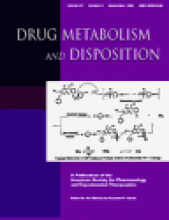Abstract
Biotransformation pathways and the potential for drug-drug interactions of the orally active antifungal terbinafine were characterized using human liver microsomes and recombinant human cytochrome P-450s (CYPs). The terbinafine metabolites represented four major pathways: 1) N-demethylation, 2) deamination, 3) alkyl side chain oxidation, and 4) dihydrodiol formation. Michaelis-Menten kinetics for the pathways revealed meanKm values ranging from 4.4 to 27.8 μM, andVmax values of 9.8 to 82 nmol/h/mg protein. At least seven CYP enzymes are involved in terbinafine metabolism. Recombinant human CYPs predict that CYP2C9, CYP1A2, and CYP3A4 are the most important for total metabolism. N-demethylation is primarily mediated by CYP2C9, CYP2C8, and CYP1A2; dihydrodiol formation by CYP2C9 and CYP1A2; deamination by CYP3A4; and side chain oxidation equally by CYP1A2, CYP2C8, CYP2C9, and CYP2C19. Additionally, characteristic CYP substrates inhibited pathways of terbinafine metabolite formation, confirming the involvement of multiple enzymes. The deamination pathway was mainly inhibited by CYP3A inhibitors, including troleandomycin and azole antifungals. Dihydrodiol formation was inhibited by the CYP1A2 inhibitor furafylline. Terbinafine had little or no effect on the metabolism of many characteristic CYP substrates. Terbinafine, however, is a competitive inhibitor of the CYP2D6 reaction, dextromethorphan O-demethylation (Ki = 0.03 μM). In summary, terbinafine is metabolized by at least seven CYPs. The potential for terbinafine interaction with other drugs is predicted to be insignificant with the exception that it may inhibit the metabolism of CYP2D6 substrates. Clinical trials are needed to assess the relevance of these findings.
Footnotes
-
Send reprint requests to: Dr. Volker Fischer, Novartis Institute for Biomedical Research, 59 Route 10, East Hanover, NJ 07936. E-mail: volker.fischer{at}pharma.novartis.com
- Abbreviations used are::
- CYP
- cytochrome P-450
- CsA
- cyclosporine A
- ESI
- electrospray ionization
- RAF
- relative activity factor
- LC-MS
- liquid chromatography-mass spectrometry
- D
- desmethylterbinafine
- OL
- hydroxyterbinafine
- DOL
- desmethylhydroxyterbinafine
- CA
- carboxyterbinafine
- NA
- 1-naphthoic acid
- NM
- 1-naphthalenemethanol
- NAL
- 1-naphtaldehyde
- Received February 17, 1999.
- Accepted May 20, 1999.
- The American Society for Pharmacology and Experimental Therapeutics
DMD articles become freely available 12 months after publication, and remain freely available for 5 years.Non-open access articles that fall outside this five year window are available only to institutional subscribers and current ASPET members, or through the article purchase feature at the bottom of the page.
|






